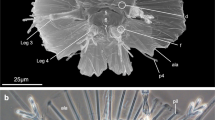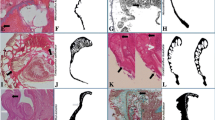Abstract
The architecture of the musculature of the eutardigrade species Milnesium tardigradum Doyère, 1840, Hypsibius sp. and Ramazzottius oberhaeuseri (Doyère in Ann Sci Nat Zool Sér 2(14):269–369, 1840) is investigated by phalloidin staining and confocal laser scanning microscopy. There are methodological problems in staining eutardigrades due to physiological alterations under stress (anhydrobiosis) and due to penetration problems of the cuticle. It is helpful to fix specimens in the state of asphyxy, where animals are stretched following an oxygen shortage in their environment. The musculatures of all three species correspond in their general architecture, but differ in detail, such as in the number of muscles. All muscles are isolated muscle strands. There are on each body side two dorsal and one ventral muscle strands, in addition to a system of dorsoventral, lateral and lateroventral muscles. Seven median ventral attachment points give rise to dorsoventral, ventrolateral and appendage muscles. The appendages receive several muscles originating dorsally and ventrally. The number of muscles and the arrangement differ in each appendage. The fourth appendage shows the greatest differences with a far smaller number of muscles compared to other species. The musculature shows comparably few strict segmental patterns, for example, the musculature of each appendage differs from the other ones. By comparison with literature data on the same species and data of Macrobiotus hufelandi it can be shown that eutardigrades have a roughly comparable muscular architecture, but that there are several differences in detail.








Similar content being viewed by others
References
Basse A (1906) Beiträge zur Kenntnis des Baues der Tardigraden. Z Wiss Zool 80:259–281
Binda MG, Pilato G (1986) Ramazottius nuovo genere di Eutardigrado. Animalia Catania 13:159–166
Dewel RA, Nelson DC, Dewel WC (1993) Tardigrada. In: Harrison FW, Rice ME (eds) Microscopic anatomy of invertebrates, vol 12. Wiley-Liss, New York, pp 143–183
Doyère L (1840) Mémoire sur les Tardigrades. Ann Sci Nat Zool Sér 2(14):269–369
Garey JR, Nelson DR, Mackey LM, Li J (1999) Tardigrade phylogeny: congruencey of morphological and molecular evidence. Zool Anz 238:205–210
Kristensen RM (1978) On the structure of Batilipes noerrevangi Kristensen 1978. 2. The muscle-attachments and the true cross-striated muscles. Zool Anz 200:173–184
Marcus E (1929) Tardigrada. In: Bronn HG (ed) Klassen und Ordnungen des Tierreichs. Akademische Verlagsgesellschaft, Leipzig, pp 1–608
Müller J (1936) Zur vergleichenden Myologie der Tardigraden. Z Wiss Zool 147:171–204
Nelson DR (1991) Tardigrada. In: Thorp JH, Covich AP (eds) Ecology and classification of North American freshwater invertebrates. Academic, San Diego, pp 501–521
Nichols PB, Nelson DR, Garey JR (2006) A family level analysis of tardigrade phylogeny. Hydrobiologia 558:53–60
Plate LH (1889) Beiträge zur Naturgeschichte der Tardigraden. Zool Jb Anat Ontog 3:487–550
Schill RO, Steinbrück GHB, Köhler H-R (2004) Stress gene (hsp70) sequences and quantitative expression in Milnesium tardigradum (Tardigrada) during active cryptobiotic stages. J Exp Biol 207:1607–1613
Schmidt-Rhaesa A (2001) Tardigrades—are they really miniaturized dwarfs? Zool Anz 240:549–555
Schmidt-Rhaesa A, Bartolomaeus T, Lemburg C, Ehlers U, Garey JR (1998) The position of the Arthropoda in the phylogenetic system. J Morphol 238:263–285
Scholtz G (2002) The Articulata hypothesis—or what is a segment? Org Div Evol 2:197–215
Schüttler L, Greven H (2000) Beobachtungen zur Lokomotion von Tardigraden. Acta Biol Benrodis 11:33–52
Shaw K (1974) The fine structure of muscle cells and their attachments in the tardigrade Macrobiotus hufelandi. Tissue Cell 6:431–445
Walz B (1974) The fine structure of somatic muscles of Tardigrada. Cell Tissue Res 149:81–89
Walz B (1975) Ultrastructure of muscle cells in Macrobiotus hufelandi. Mem Inst Ital Idrobiol 32(Suppl):425–443
Acknowledgments
We thank Birgen Holger Rothe (Bielefeld) for his help in this project.
Author information
Authors and Affiliations
Corresponding author
Additional information
Dedicated to Professor Westheide on the occasion of his 70th birthday.
Rights and permissions
About this article
Cite this article
Schmidt-Rhaesa, A., Kulessa, J. Muscular architecture of Milnesium tardigradum and Hypsibius sp. (Eutardigrada, Tardigrada) with some data on Ramazottius oberhaeuseri . Zoomorphology 126, 265–281 (2007). https://doi.org/10.1007/s00435-007-0046-0
Received:
Accepted:
Published:
Issue Date:
DOI: https://doi.org/10.1007/s00435-007-0046-0




